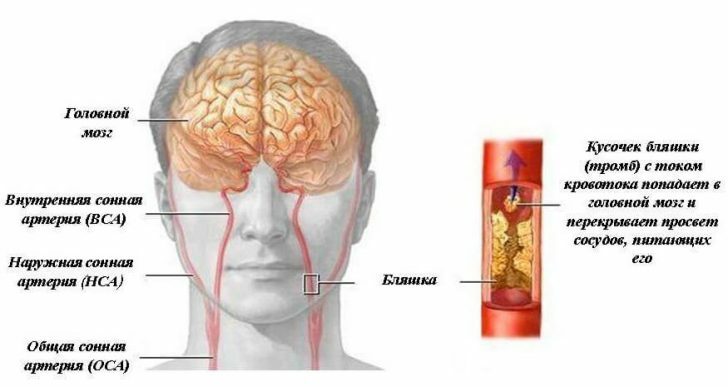Sciatic nerve inflammation, symptoms and treatment at home
In this article, we will answer in detail what is sciatic nerve inflammation, we will reveal the causes, symptoms and home treatment conditions.
Sciatica is an inflammation of the sciatic nerve that occurs as a result of the pinching of the nerve itself or its endings.
The sciatic nerve is the longest in the human body. It starts in the lumbar region, runs through the pelvic region to the thigh, and ends at the big toe.
Content
- Causes of sciatica
- Sciatic nerve inflammation symptoms
- Diagnostics and examination
- Sciatic nerve disease treatment
- Sciatica treatment at home
- Drug treatment
- Massage
- Traditional methods of treatment
Causes of sciatica
The disease does not arise by itself, but as a rule is a consequence of the impact of other pathologies on the human body, especially on the spine. Among the causes of sciatica are the following:
- Infectious neuritis. Some diseases can cause an infectious damage to the nerve, which occurs due to exposure to toxic substances formed during the course of these diseases. Such diseases include: syphilis, typhus, tuberculosis, malaria and other diseases that contribute to the extensive spread of internal purulent infections.
- Intoxication. Due to exposure to certain poisons or alcohol. There are also cases of inflammation of the nerve with substances that the body itself produces, as a result of damage by diseases such as diabetes or gout.
- There are causes of nerve inflammation that are not related to the spine. One of them - muscle spasms the pelvic-sacral region, in particular piriformis muscle.
- Lumbar disc herniation. The formation of a hernia is accompanied by a displacement of the vertebral discs, which as a result can cause infringement of the nerve endings of the spinal cord, as a result of which the sciatic nerve can become inflamed.
- Spine diseases. As a result of some pathologies (osteochondrosis, osteoarthritis of the intervertebral joints), on the intervertebral discs bone formations are formed, which can have a compressive effect on the spinal nerves endings.
- Postpartum complicationsas well as complications during pregnancy. During pregnancy, the bone structure of the pelvic-sacral region is subject to an unbalanced load, which can provoke pathological processes in the body, which is not physically prepared for the increased stress on spine.
Sciatic nerve inflammation symptoms
Signs of the manifestation of the disease, one way or another, are associated with pain in the lumbar region, lower extremities, a certain general malaise. At various stages of sciatica, symptoms may be characteristic of them, but most often the following is observed:
- acute pain syndrome, with the slightest disturbance of the lumbar region as a result of bending or walking;
- weakness that occurs in the lower extremities, which is often accompanied by periodic numbness;
- when trying to change the position of the body (stand up, sit down), there may be a sharp shooting pain in the lower back, or along the entire length of the nerve;
- while in a sitting position, the patient may feel a growing pain in the buttocks;
- pain in the lower extremities is sometimes accompanied by burning, tingling, itching, numbness;
- during the course of the disease, lower back pain may bother less often than pain that is localized on the back of the leg, starting from the buttocks and ending with the feet.
Cases of bilateral sciatica are extremely rare. Inflammation most often wears unilateral the nature and in most cases the pain syndrome extends to the right leg.
At the initial stage, the symptoms of sciatica can manifest themselves, in the form of a flaccid pain syndrome lumbar region and leg aches, which are often mistaken for the consequences of overwork. This course of the disease can be observed for quite a long time, sometimes years.
Read also:Lumbago: what is it, causes, symptoms, diagnosis, treatment, prevention

Aggravation, usually happens suddenly and some trifle serves as an impetus to it, like a wrong landing after a small jump, an unsuccessful tilt, hypothermia, weight lifting. In most cases, these events are associated with the appearance of sciatica.
Diagnostics and examination
An experienced doctor can unambiguously identify inflammation of the sciatic nerve at the examination stage. But, given that this ailment is a consequence of other pathologies, for further productive treatment it is necessary to find out their nature, the degree of neglect.
Methods for diagnosing the causes of sciatic nerve inflammation:
- X-ray. Using this method, you can identify, for example, osteochondrosis, but some other pathologies, such as a hernia of the spine, cannot be detected by radiography.
- MRI (magnetic resonance imaging), CT scan. Unlike radiography, this type of examination allows you to obtain information about the state of soft tissues, such as muscles, blood vessels, nerve endings. In addition, thanks to three-dimensional modeling, you can see a complete picture of the state of the vertebral discs.
- It is mandatory to conduct neurological examination, to assess the level of damage to the patient's nervous system.
- Electroneuromyography. This type of examination is needed to obtain detailed information about the condition of the patient's muscles and nerve endings.
Sciatic nerve disease treatment
First of all, it is important to ensure peace, to minimize any movements that can lead to muscle spasms in the lumbar and pelvic region.
It is advisable to stay in bed. The base on which the patient will lie should be flat and semi-rigid.

For the treatment of sciatica, the methods described below are characteristic:
- Treatment with medications.
- Acupuncture.
- Osteopathy.
- Traditional methods of treatment.
- Massage procedures
- Other, unconventional methods (mud therapy, leech therapy, etc.).
Surgery in the treatment of sciatica is used quite rarely and consists in eliminating the pathologies that led to sciatica (reduction of a hernia of the spinal column, removal of bone formations, etc.).
Read also:Gliosis of the brain: causes, symptoms, treatment and prognosis
Sciatica treatment at home
As soon as the first signs of sciatica were noticed (this is usually aching pain in the lower back and legs, perceived as a consequence of overwork), one should think about the reasons that caused these symptoms.
Often this is a sedentary (sedentary) lifestyle and, as a result, underdeveloped vertebral muscles. Physical overload, accompanied by hypothermia.
If you minimize the impact of these factors, it is possible to avoid a subsequent exacerbation.
During home treatment, you need to follow some guidelines:
- The spine should not be in an upright position for a long time; it is necessary to lie down periodically so that the lower back and legs can rest.
- While walking, you need to monitor the position of the feet, it is desirable that they are parallel to each other. It is also not recommended to wear shoes with heels.
- The position of the back also plays an important role as the cause of sciatica and subsequent exacerbations. The back must be kept straight, avoiding overwork.
- In a horizontal position, it is better to lie with your knees bent.
- Healthy sleep and proper nutrition will help create favorable conditions for subsequent recovery.
- For people who are overweight, it is advisable to lose it.
In the event of a sudden onset of acute pain caused by sciatic nerve entrapment, the first remedy that can alleviate pain is take the pose of an embryo (lie on the unaffected side and squeeze the injured leg to the body; in the case of bilateral sciatica, lie on your back and squeeze both legs).
Drug treatment
- Analgin and preparations based on it. This tool is the most widespread and available, therefore, it is often used first. It is used for pain relief, relieves inflammation, and can have antipyretic effects.
- Diclofenac. Strong pain reliever and anti-inflammatory drug. Relieves swelling and reduces the intensity of muscle spasms that cause pain. A popular, effective remedy for sciatica symptoms.
- Non-steroidal anti-inflammatory drugs (Meloxicam, Movalis). These drugs have a powerful sedative, analgesic effect on the affected area. They are used during acute pain syndrome when diclofenac fails.
- Novocaine blockade. Novocaine is able to block nerve impulses that cause pain. It is used in cases of particularly intense pain, as a local anesthetic.
- Ointments, rubbing (Voltaren, Ketorol, Ksefokam). Some substances, when applied externally, are capable of causing processes in the skin that help eliminate the symptoms of sciatica. Providing an irritating effect on the receptors of the skin, it stimulates the release of substances that help to eliminate pain, normalize blood circulation, and relieve puffiness.
Read also:Transient ischemic attack (TIA)
Massage
Massage procedures are possible at any stage of sciatica development. The difference lies in the intensity of the therapy, and in the drugs used in the process.

The use of massage can have the following positive effects:
- Improving the blood supply to the tissues of the affected area and the nerve endings of the spinal cord.
- Elimination of excessive tone in the muscles of the lower back and along the entire length of the sciatic nerve.
- Reduction of swelling as a result of the normalization of the outflow of lymph from the affected areas.
- Stimulating the secretion of biologically active substances by the skin, which have anti-inflammatory and analgesic effects.
- Provides a distracting effect, especially when combined with special oils and ointments.
Massage recommendations:
- In case of exacerbation of sciatica, the massage should not be intense, but rather similar to stroking and light rubbing. Harder techniques can cause pain.
- In the stage of remission, when pain and other symptoms are not so intense, it is possible to use more intense complex massage techniques, including reflex-segment, acupressure and vacuum massage.
- If the cause of the nerve inflammation is sciatica of the lumbosacral department, apply massage of the lower back, back of the buttocks and legs in general.
- Correctly selected oils, in a competent combination with warming rubbers and ointments, will help to make the positive effect of massage even more effective.
- Each massage session should not last more than half an hour. Also, after a ten-day course, you need to take a short break (2-3 days).
Traditional methods of treatment
- Finely grate horseradish or radish, wrap the resulting substance in a thin cloth or gauze and apply as a compress to the affected parts of the body (usually to the lower back).
- Fresh beeswax from the hive you need to warm up in a water bath to a soft plastic state (but not to a liquid one). After that, the wax should be put on the lower back, covered with cellophane and wrapped with something warm. It is advisable to do this before going to bed at night.
- Thyme herb, viburnum flowers, calendula are taken in equal proportions (5 g), 10 g of horsetail herb is added to them, and all this is poured into 0.5 liters of boiling water. Then they insist on a water bath for 10 minutes. Take orally 100 g before meals 3 times a day.
Treatment only with folk methods will not lead to final recovery. Would need comprehensively apply all existing methods, the prescription of which should be dealt with by a competent neurologist.



